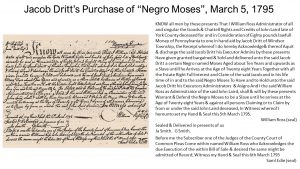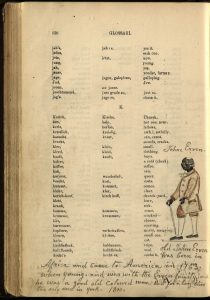RiverRoots:
Searching for Moses
River Roots: Searching for Moses
River Roots is Susquehanna NHA’s blog series featuring history from York and Lancaster Counties that showcases the Susquehanna River’s historic, cultural, and natural resource contributions to our nation’s heritage.
Here in Pennsylvania, slavery can feel very distant from our local histories. We think of slavery as a Southern institution that had no place here. After all, Quakers founded Pennsylvania, and they were some of the earliest abolitionists. However, slavery is absolutely part of our local heritage. The last enslaved Pennsylvania was not freed until 1847, a mere 14 years before the Civil War began. If we continue to distance ourselves from this shameful part of our past, we will never really understand our history. Without a complete picture of our past, we will always have trouble moving forward.
Finding Moses in the Will of Jacob Dritt
The elegant mid-1700s mansion at 1706 Long Level Road was once the home of Jacob Dritt and his family. It now houses the Zimmerman Center for Heritage. Susquehanna National Heritage Area’s staff tell the tales of those who used to live in the house.
Our staff studies both primary and secondary sources about the Dritt family. Lately, we have focused our research efforts on a man that Jacob Dritt mentioned in his will. Dritt was a prominent York County citizen who owned the Zimmerman property from 1783 until his death in 1817. His family continued to own the estate until 1851. In his will, Dritt bequeathed a person named Moses twenty dollars for “a suit of clothes.”

Finding the Purchase Document

The bill of sale we discovered proves that Dritt bought a ten-year-old child named Moses on March 5, 1795. By the time that Dritt purchased Moses, people had lived in slavery here in PA for over 150 years. Nearly 160,000 people (including Moses) were in legal bondage in the Chesapeake area.
Five years before Moses was born, the Colony of Pennsylvania passed the Gradual Abolition of Slavery Act of 1780. It was one of the abolitionist movement’s earliest successes. As the name suggests, the Act did not end slavery in PA overnight. Instead, it started a gradual process to end slavery over a long period of time. It mandated that anyone born to an enslaved woman after 1780 would be manumitted (freed) at the age of 28. Previously, any child born to an enslaved mother would have lived in slavery until they died. Since Moses was born around 1803, the Act freed him in 1813, 18 years after Dritt bought him. The Act also required official sales records, known as “purchase documents.” These documents recorded the enslaved person’s birth year. This is why the proof that Jacob Dritt bought Moses in 1795 exists.
What else can we learn from documents?
Each document about Moses that we discover inspires more questions and answers about his life. The bill of sale tells us that Dritt bought Moses from another local, John Laird, who regularly sold enslaved people. The Laird estate was about seven miles from Jacob Dritt’s property. How did Dritt learn that Moses was for sale? Was he aware of the child before 1795? Were Dritt and John Laird acquaintances?
It is unclear if Moses was born and raised on Laird’s land. Did Moses’ mother still live there after 1795, or did Laird’s administrators sell her as well as her son? Dritt and Laird’s properties were within the ten-miles of each other. Moses, therefore, could have traveled between the two estates without a pass under Pennsylvania law. If he had a family on the Laird property, was he permitted to visit them? Research into the Laird estate and will could shed light Moses’s life before Dritt bought him.
We also continue to search for information about Moses’s life at the Dritt Mansion. What motivated Jacob Dritt to buy a child? What tasks did Jacob Dritt assign a ten-year-old boy? He paid 80 pounds in Pennsylvania currency for Moses. How did the value of this sale compare to others at the time? What happened between Moses’s dictated manumission (1813) and Dritt’s death (1817). For these four years, was Moses a paid employee at the Dritt Mansion? Did he work on Dritt’s ferry? Did he have his own boat? Did he cross the river and attend the African Methodist Evangelical Church in Lancaster County? We do not know yet. Dritt’s will stated Moses would inherit twenty dollars for a suit of clothes. Did he ever buy his suit?
Moses Receives his Suit
We asked the York County History Center to help us answer this last question. We requested the 1821 last will distribution record of Jacob Dritt, and they graciously provided it to us. Moses received part of his inheritance between Dritt’s death in 1817 and the distribution in 1821. Adam Klinefelter, a tailor in York, received ten dollars on Moses’s behalf. That was half the money promised to Moses.

A master often promised an indentured servant a suit at the end of their indenture to help them in the next stage of life. This could have applied to people in term slavery. A prominent business owner in York, William Goodrich, received manumission at 28 and got a Bible and a suit to mark this transition to freedom. Pre-Civil War slave narratives show how a suit discouraged kidnappers who seized people of color and illegally sold them. A suit would have helped ease interactions with local patrols seeking passes or manumission papers. For these reasons, a suit would have been valuable to Moses.
We continue searching for Moses in more documents. Our first task is to search for a record that will tell us the surname he chose after his manumission. No one has found him yet in tax records as a free man. We have not located him in the burial records of York County. We will look for his name in church records, death records, administrative records, and tax records and even illegal sale records. These sources might help us learn about what happened to him after his manumission date. Moses lived during dangerous times when bounty hunters kidnapped free blacks and sold them to Southern slaveholders. He lived here for decades on the shores of the Susquehanna. The documents place him here in the historic home that is now the Zimmerman Center for Heritage.
We want to find more information about Moses and his life, so we can continue to tell his story. As we continue to research Moses’s life, we will invite collaborators to help us.
When we tell stories about the people of our heritage, we learn a bit more about ourselves. We invite you to visit our facilities soon and find out what we have learned lately. You are also welcome to share any documents you have found that can help us as in our search for Moses.
Learn More
- William Still’s The Underground Railroad is a collection of interview notes from Still’s time with an abolitionist network in Philadelphia. His notes about freedom seekers were carefully preserved during the years after the Fugitive Slave Act of 1850. These notes give brief but truthful insights into the lives of the enslaved people before and after they sought freedom.
- Incidents in the Life of a Slave Girl by Harriet Jacobs provides an eye-opening account of how women of color were brutalized by slavery.
- Stolen: Five Free Boys Kidnapped into Slavery and their Astonishing Odyssey Home by Richard Bell is an excellent book. It tells the incredible story of slave traders that stole thousands of free black people during the early nineteenth century. Accounts of the illegal trade illuminate the dangers of living without the benefits of citizenship.
Resources
Tritt, R. L., et al. Tritt Family History Ancestry, Volume 1, Ancestry, Life and Times of Brothers Hans Peter and Christian Tritt, immigrants to Pennsylvania in 1739, and their children Tritt Family Research, Inc., 1999
Baptist, E. E., The Half Has Never Been Told: Slavery and The Making of American Capitalism, Basic Books, New York, 2014
Bell, R., Stolen: Five free Boys Kidnapped into Slavery and Their Astonishing Odyssey Home, 37INK/Simon & Schuster, Inc., New York, New York, 2019
McClure, J., Almost Forgotten: A glimpse at black history in York County, Pa., York Daily Record/York Newspaper Co., 2002
Schick, J., Slavery in Pennsylvania, Friends Journal, September 1, 2012
